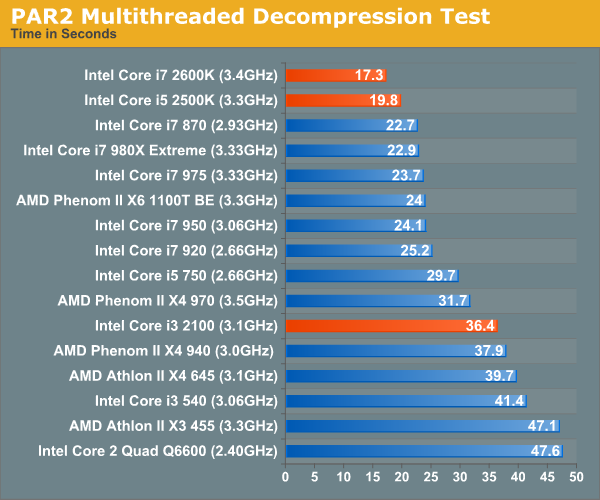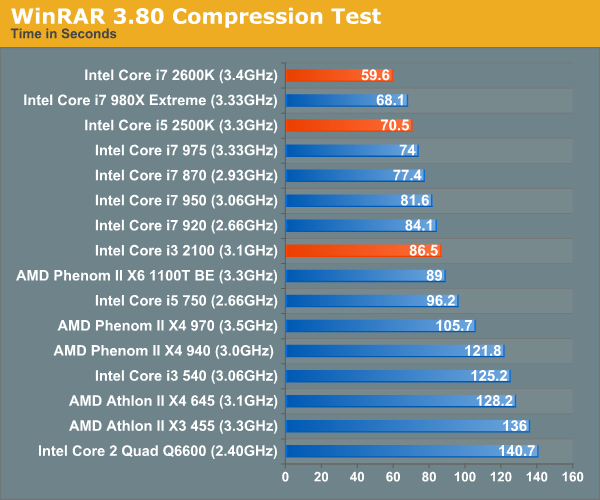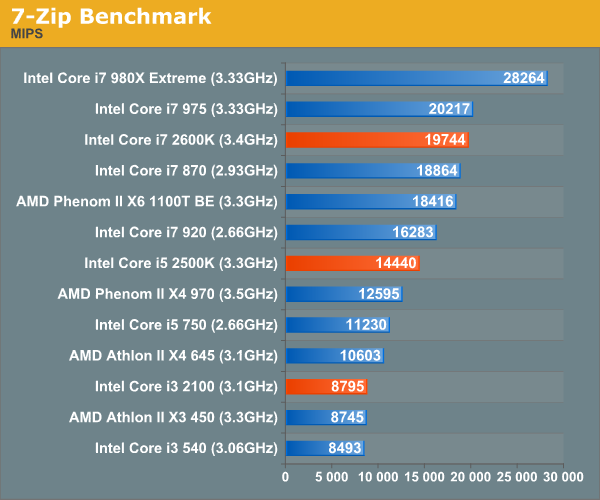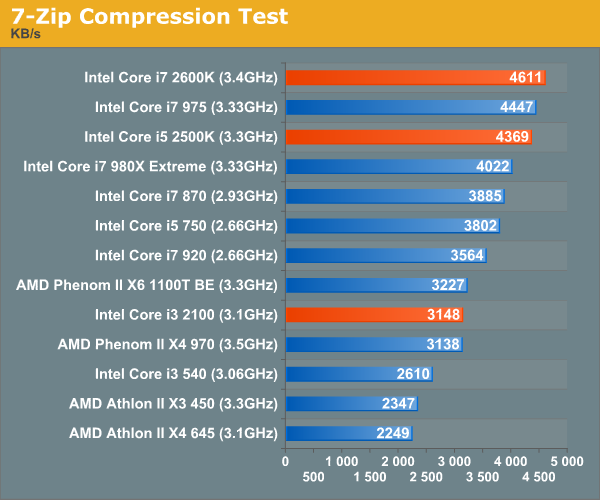The Sandy Bridge Review: Intel Core i7-2600K, i5-2500K and Core i3-2100 Tested
by Anand Lal Shimpi on January 3, 2011 12:01 AM ESTFile Compression/Decompression Performance
Par2 is an application used for reconstructing downloaded archives. It can generate parity data from a given archive and later use it to recover the archive
Chuchusoft took the source code of par2cmdline 0.4 and parallelized it using Intel’s Threading Building Blocks 2.1. The result is a version of par2cmdline that can spawn multiple threads to repair par2 archives. For this test we took a 708MB archive, corrupted nearly 60MB of it, and used the multithreaded par2cmdline to recover it. The scores reported are the repair and recover time in seconds.

Here both the K-series SKUs are faster than the 980X. The Core i3 2100 manages a 13% lead over the Core i3 540.
In all of our compression tests, Sandy Bridge does very well. The 2600K is faster than the 980X in the real world compression tests, while the 7-Zip algorithm benchmark is fully threaded and shows you what would be possible with 6-cores.













283 Comments
View All Comments
omelet - Monday, January 3, 2011 - link
> The Sandy Bridge Review: Intel Core i5 2600K, i5 2500K and Core i3 2100 TestedDoesn't look fixed over here.
Zoomer - Monday, January 3, 2011 - link
Score one for intel marketing!Oh wait...
Beenthere - Monday, January 3, 2011 - link
I'll stick with my AMD 965 BE as it delivers a lot of performance for the price and I don't get fleeced on mobo and CPU prices like with Intel stuff.geek4life!! - Monday, January 3, 2011 - link
Exactly what I have been waiting on, time to build my RIG again. Been without a PC for 1 year now and itching to build a new one.Game on baby!!!!!!!!!!!!!!
Doormat - Monday, January 3, 2011 - link
If QuickSync is only available to those using the integrated GPU, does that mean you cant use QS with a P67 board, since they don't support integrated graphics? If so, I'll end up having to buy a dedicated QS box (a micro-ATX board, a S or T series CPU seem to be up to that challenge). Also what if the box is headless (e.g. Windows Home Server)?Does the performance of QS have to do with the number of EUs? The QS testing was on a 12-EU CPU, does performance get cut in half on a 6-EU CPU (again, S or T series CPUs would be affected).
No mention of Intel AVX functions. I suppose thats more of an architecture thing (which was covered separately), but no benchmarks (synthetic or otherwise) to demo the new feature.
MeSh1 - Monday, January 3, 2011 - link
Yeah I think this is the case or according the the blurb below you can connect a monitor to the IGP in order to use QS. Is this a design flaw? Seems like a messy workaround :(" you either have to use the integrated GPU alone or run a multimonitor setup with one monitor connected to Intel’s GPU in order to use Quick Sync."
SandmanWN - Monday, January 3, 2011 - link
The sad part is for all the great encoding you get, the playback sucks. Jacked up.Doormat - Monday, January 3, 2011 - link
I'm not that interested in playback on that device - its going to be streamed to my PS3, DLNA-enabled TVs, iPad/iPhone, etc. Considering this wont be supported as a hackintosh for a while, I might as well build a combo transcoding station and WHS box.JarredWalton - Monday, January 3, 2011 - link
How do you figure "playback sucks"? If you're using MPC-HC, it's currently broken, but that's an application issue not a problem with SNB in general.Absolution75 - Monday, January 3, 2011 - link
Thank you so much for the VS benchmarks!! Programmers rejoice!